Health & nutrition insights.
Six Stretches Physical Therapists Wish You Would Do
Movement is medicine, and stretching is an important part of your daily movement routine. In addition to improving your mobility, stretching can also assist with strength building, chronic pain, and can be very relaxing. Let’s look at 6 different physical therapy stretches that would make your physical therapist happy!
*Note – There are certain health conditions and musculoskeletal disorders that you may want to be very gentle or avoid some of these. If any of these stretches cause you an increase in pain, it may be best to get evaluated by a physical therapist first. Every person is unique, and these physical therapy stretches may not be for everyone.
-
Figure 4 Stretch
This stretch is great to do if you are experiencing tightness or tension in your lower back and hips. Contraindications for this stretch may include, but is not limited to, post surgery, acute herniated disc, and hip impingement. It stretches:
-
-
Glutes: – this especially true for the glute medius which is located on the side of your hips. This muscle plays an important role in hip and pelvic stability.
-
-
-
Piriformis – This little guy is located deep in the hip and is tricky to stretch, but often is the cause of many people’s pain and discomfort.
To begin, lay on your back with one knee bent. Cross your ankle over the knee. Grab behind your bent knee and pull towards your chest. If you are not as flexible, you can use a towel or simply pull your crossed leg towards your opposite shoulder.
-
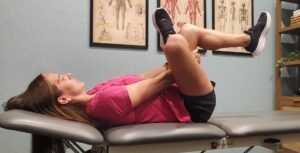
Figure 4 stretch for hips and lower back. Hold 30 seconds.
-
-
Lumbar Extension
Lumbar extension is known to help with low back pain. It can also help with sciatica, and it is beneficial for certain disc injuries. Certain low back disorders that lumbar extension should not be performed, such as post surgery and spinal stenosis. If this reproduces your pain, do not do this. Research such as this have determined this to be a superior home exercise program.
Lay on your stomach and gently press up onto your elbows. If this is difficult for you, simply start by laying on your stomach.

Hold a few seconds and repeat.
-
Thoracic Spine Extension
A majority of us have sedentary jobs and spend a lot of our day sitting. Unfortunately, this can lead to poor posture. This stretch will help open the chest, arms, and assist with posture!
Seated in a chair that comes to your mid back, lock your hands behind your head and pull your elbows apart. Lean back to extend your middle over the chair. This can also be performed with a foam roller.
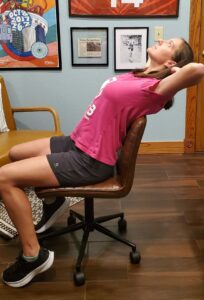
Hold 10-15 seconds
-
Chin Tucks
Cervical retraction is a good stretch for someone experiencing neck pain. Fun fact. . . the average human head weights around 10 lbs, and all that weight is balance on 7 vertebra that make up you neck! This stretch promotes proper posture and helps undo the stress we put on our neck and spine with activities such as reading or looking at our phones.
Laying on your back and keeping the back of your head in contact with the bed, gently glide your chin back. Do not lift your head or flex your neck.
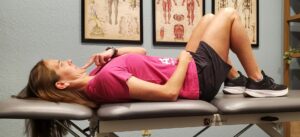
Hold just a few seconds and repeat
-
Gastrocnemius (Calf) Stretches
Our culture is prone to having tight calves. Sitting and sleeping put our calves in a shortened position for several hours at a time. Tight calves can impair our normal gait mechanics, and make us compensate when walking or running.
Standing at a wall, keep your back knee straight and heel on the ground. Lean forward at the ankle until you feel a pull in the back of your lower leg. An advanced version would be to hang your heel off a curb or step and while keeping your knee straight drop your heel until you feel a pull in the calf.
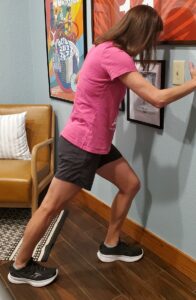
Hold 30 seconds
-
Quad Stretches
The knee is one of the hardest working joints in the body, and it gets stressed with daily activities such as walking, stairs, and squatting. It gets lots of use in the gym as well. Keeping the knee flexible can help prevent injury.
Standing with your tailbone tucked (be sure not to arch in your lower back), pull your heel up towards your bottom. To modify, a towel or heavy band can assist pulling your heel up, or this can be performed laying on your side.
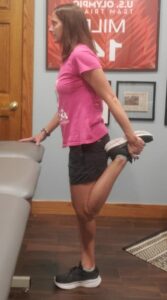
Hold 30 seconds
Also, let us not forget about dynamic physical therapy stretches! Dynamic stretching is better prior to working out, and static stretching (long holds) is better post working out. Research actually indicates that holding a stretch for a prolonged period of time can fatigue the muscle and cause injury if followed by an explosive or powerful exercise, according to this journal article.
